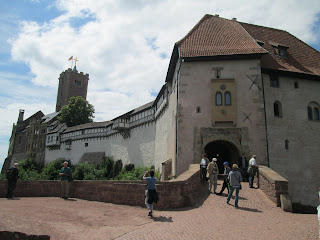In Eisenach we learned more about Bach, for this is his birthplace. We has the privileged of touring the museum here, as well as listen to a brief live musical demonstration on five instruments, some of which came from the time of Bach.
Much of the exhibit was interactive, so we were able to enjoy samples of his music in these listening pods.
They had a sample of a bronze cast of his skull (weird, right?) coupled with renditions from many different artists who captured Bach when he was alive. The combination of these give us a cross sample of Bach's living image with his poor dental health. All the same, it was impressive.
During the mini-concert, our fellow tourist participated in the concert by manual working a pedal to feed air into one of the two pump organs.
In addition to the instruments whose names I cannot repeat without offending Lenore or Craig (organists as North New Hope and Faith, respectively), there was an instrument invented by Benjamin Franklin called the Glass Harmonica.
After the concert, we may our way to the Lutherhaus, or Luther House. It was in this house Luther stayed while he attended our equivalent of Jr. High and High School. Outside is planted an apple tree, in homage to a quote I won't repeat because the earliest record of this phrase document comes as late at 1949, but the legend has been so strong that this apple tree stands.
Just up the hill, or rather the correct term is mountain, is Wartburg Castle. It is in this location that Martin Luther, after having been secretly kidnapped by Frederick the Wise to ensure his safely, was keep hidden after standing firm in his theological conviction before the emperor and the church at the Diet of Worms. While in safety, he translated the New Testament from the original Greek to German. As I mention prior in this blog, it was Martin Luther's translation that brought together all the varying dialects of the German people, 18 differs ways of speaking, into a single and common language we know today as German. Luther's translation of the Bible was so accurate that 60% of it still makes us today's German translation.
For what it's worth, in the past several decades, 78 people have died making the climb up to Wartburg castle. They have minivans now...also, donkey rides to which our guide objected to due to their fragrant nature.
The chapel.
Backstage view of the jester's court.
Wartburg Castle has about 900 years of history in it, but I cannot go into all of his here. The castle has been recovered and restored in the past 100 years, reclaiming much that has been damaged over time and neglect. However, there is still the preserved room in which Luther spent 10 grueling weeks translating Greek into German.
The hallways were a bit cramped, but people were shorter then.
From here, we concluded our tour with a 3 hour bus ride to Darmstadt, where we stayed our last night in Germany.



































































